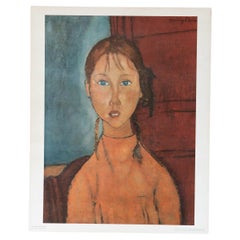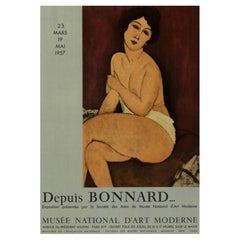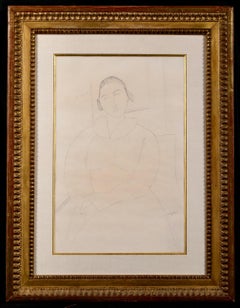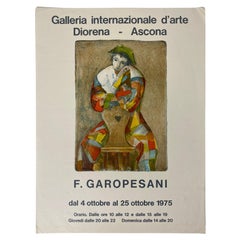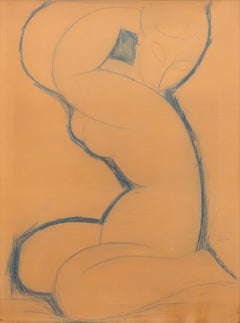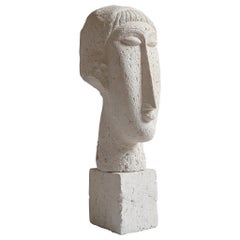Amedeo Modigliani Furniture
to
2
2
3
2
2
1
1
Modigliani Amadeo “Girls with Braids” Abrams Print, circa 1970
By Amedeo Modigliani
Located in Barcelona, ES
Modigliani Amadeo “Girls with Braids” Abrams Print, circa 1970
An Abrams Color Print,
Printed in Holland by Smeets Weert.
In original condition, with minor wear consistent of age...
Category
1970s Dutch Mid-Century Modern Vintage Amedeo Modigliani Furniture
Materials
Paper
$533 Sale Price
50% Off
Original Vintage Fine Art Exhibition Poster MODIGLIANI DEPUIS BONNARD, 1957
By Amedeo Modigliani
Located in Melbourne, Victoria
Original vintage Fine art exhibition poster MODIGLIANI DEPUIS BONNARD, 1957
This is an original vintage poster from 1957
Artist
Modi...
Category
1970s French Mid-Century Modern Vintage Amedeo Modigliani Furniture
Materials
Paper
$960 Sale Price
20% Off
Portrait of Berthe Lipchitz - Modern Portrait Pencil Drawing - Amedeo Modigliani
By Amedeo Modigliani
Located in Marlow, Buckinghamshire
Signed pencil on paper portrait drawing by Italian artist Amedeo Clemente Modigliani. The portrait is of Berthe Lipchitz who was the wife of Modigliani's friend, the sculptor Jacques Lipchitz. This work is a study for "Portrait of Jacques & Berthe Lipchitz" which hangs in the Art Institute of Chicago.
Signature:
Signed lower right
Dimensions:
Framed: 26.75"x18.25"
Unframed: 18.75"x12.25"
Provenance:
The collection of Leopold Survage
The collection of Dimitri Snegaroff
The collection of Leopold Zborowski
Galerie Charpentier - Paris 1958
Private french collection
Galerie Pierre Levy - Paris
Private collection - United Kingdom
Exhibited:
Galerie Charpentier - Cent Tableaux de Modigliani - Paris, 1958
Les Peintres de Zborowski - ~Foundation L'Hermitage, Lausanne 1994
Amedeo Modigliani Exhibition - Museo d'Arte Moderna, Lugano 1999
Amedeo Modigliani was born into a middle-class Jewish family and was the brother of Eugenio Modigliani, who later became the leader of the Italian socialist workers’ party prior to the rise of fascism. Modigliani suffered from poor health as a child and contracted pleurisy in 1895, followed in 1898 by typhus with pulmonary complications, which culminated in tuberculosis in 1901. He moved to Livorno to study under Guglielmo Micheli, who had himself been a pupil of Giovanni Fattori, one of the Macchiaioli group of painters who worked in strong colour patches (macchie) to achieve vivid light and colour effects; their approach came as a reaction against academic art in Italy and, in much the same way as the French Impressionists, they advocated painting from nature rather than aspiring to communicate any particular message or ideology. In 1902, Modigliani enrolled at the academy of fine arts in Florence. He travelled to Rome and Venice in 1903, where he devoted the bulk of his day to visiting museums. At around this time he started to read Dante, dreaming no doubt of the Vita Nuova; he also devoured the works of Leopardi, Carducci, d’Annunzio, Spinoza and Nietzsche.
In 1906, Modigliani moved to Paris, lodging at the Rue Caulaincourt. At that juncture, nothing about him appeared to presage the brilliant career that was to follow. His arrival in the artists’ quarter, then known colloquially as the maquis - the labyrinthine tangle of narrow streets around today’s Avenue Junot in Montmartre - went virtually unnoticed by the artists already living and working there, including Picasso, Braque and Derain. Modigliani’s painting made next to no immediate impact and he was recognised primarily on account of his frail constitution, flashing eyes, innate elegance and intellectual prowess. He was accepted in the community that was Montmartre but never belonged to any particular ‘set’ or circle, and there is no record of his ever having been invited to Pablo Picasso’s studio, the famous ‘wash house’.
The literate and highly articulate Modigliani opted instead for the companionship of Maurice Utrillo, an instinctual painter of whom it could charitably have been said that his conversation was, at best, limited. Nonetheless, Modigliani and ‘Litrillo’ (as Utrillo was commonly known to the street urchins - the ‘p’tits poulbots’) began to frequent the cabarets and dance halls of the Butte de Montmartre, and the nefarious hashish dens - post-Baudelaire ‘institutions’, frequented in the main by out-of-work writers and talentless artists. Modigliani developed an addiction, which, compounded by his alcoholism, took its toll. It also transformed him from an artist of limited ability into one devoid of bourgeois scruples.
In his monograph, Modigliani: Sa Vie et Son Oeuvre, written in 1926 shortly after Modigliani’s death, André Salmon hinted at a ‘pact with the devil’. While somewhat overstating the case, this rather unpromising painter from Livorno metamorphosed virtually overnight into an artist of rare ability and sensitivity. The turning-point came in 1907, when Modigliani met Paul Alexandre, a doctor who befriended him, took him under his wing and purchased some of his work. The banal paintings he had turned out in Montmartre were suddenly superseded by exceptional works, produced first in Montmartre ( Cellist, 1909), and then in Montparnasse.
In Montparnasse, Modigliani started to move in artistic circles, meeting Chaim Soutine, Marc Chagall, Jules Pascin and others, all of whom lived and worked in the building in the Rue Vaugirard known as ‘La Ruche’ (‘the beehive’). Then, in the Cité Falguière, he met the Romanian-born sculptor Constantin Brancusi, who encouraged him to take up sculpture, which he did, between 1909 and 1913. In 1914, several dealers, including the erstwhile poet Léopold Zborowski and the collector Paul Guillaume, tried with little success to market Modigliani’s paintings. From 1914 to 1916, Modigliani was caught up in a tempestuous affair with the English poet and journalist Beatrice Hastings. In 1917, however, he met Jeanne Hébuterne at the Colarossi Academy, who became his constant companion and model, and who gave birth to their daughter Jeanne in 1918. In 1918 and 1919, Modigliani and Jeanne spent time in Nice on the Côte d’Azur but by 1920 he was suffering from tubercular meningitis. His friends, Kisling and the Chilean Ortiz de Zarate, brought him and a pregnant Jeanne back to Paris, where he died on January 20 1920 in the Hôpital de la Charité. His last words were reputed to be: ‘Cara Italia’. Modigliani’s brother, by this time a socialist member of parliament, telegrammed instructions to ‘bury him as befits a prince’. Jeanne Hébuterne, a budding twenty-year-old painter, killed herself and her unborn child on the day of Modigliani’s funeral by jumping to her death from a fifth-floor window.
Modigliani’s first paintings were undistinguished portraits in the Impressionist manner. After moving to Paris in 1907, his early work was influenced by the Swiss-born lithographer Théophile Alexandre Steinlen, Henri de Toulouse-Lautrec and Pablo Picasso, the latter then in his ‘blue’ period. From the onset, Modigliani’s principal preoccupation was the human figure. After the artistic (and literal) limbo of Montmartre, when his output was confined to a few Expressionist-like paintings of street life, the theatre and the circus, Modigliani suddenly erupted on the scene in 1909 with Cellist, a robust, well-constructed and vividly coloured canvas that utterly exceeded all prior expectations. He had not taken part in the protracted debates that took place nightly in Picasso’s studio, but he had superficially assimilated the Cubist ideas developed by Picasso and Georges Braque. Above all, Modigliani had been influenced by African art, which was a key feature of the Cubist movement. He succeeded in treading a fine line between the coolly analytical Cubist approach and the all-too-common European perception of African art as a succession of exaggerated facial grimaces.
It would appear that Modigliani had always been attracted to sculpture as a discipline. The friendly encouragement he received as of 1909 from Brancusi no doubt intensified his interest and reinforced his attempts to achieve a sustained simplicity of line and form. In 1910, he befriended the Russian artists Alexander Archipenko and Jacques Lipchitz, both of whom recorded Modigliani’s distaste for modelling in clay (which he referred to as ‘mud’), on the grounds that it degraded the art of sculpture. Like Brancusi, Modigliani believed in working directly, carving from wood in the case of two extant pieces, and from (sand)stone in others, with the exception of a few bronzes which were, presumably, modelled in clay before being cast into bronze. His sculpture was influenced by archaic and non-western cultures - early Graeco-Roman, African and Khmer - as well as heads carved on columns adorning the façades of Romanesque and Gothic cathedrals (Modigliani rarely sculpted a rear view of his figures). Up to approximately 1912, his sculptures take the form of tall cylinders, usually with elongated heads and shallow relief indentations or projections to indicate the hairline, facial features and neck. He departed from this style only infrequently, most notably in a small number of pieces believed to have been sculpted in 1913, which are characterised by a compressed, cubistic format and shallower and less distinct features. Modigliani eventually abandoned sculpture, presumably because of his general health and circumstances, and possibly due to the fact that his sculptures sold for even less than his paintings. During the years that he devoted to sculpture, Modigliani is recorded as producing only thirty canvases, although after 1913 his sculpture became reflected in his painting.
Following his Montmartre days, Modigliani’s work developed in both quantitative and qualitative terms, presumably helped by the relative stability of his relationship with Jeanne Hébuterne. The first paintings after his short-lived sculptural phase saw him revert briefly to Neo-Impressionist pointillism, followed by a episode marked by Cubism, which was mainly evident in portraits of friends and fellow artists living and working in Montparnasse: Henri Laurens; Juan Gris (1915); Jacques Lipchitz and his Wife; Chaim Soutine; Léopold Sauvage; Paul Guillaume; Max Jacob; Béatrice Hastings con Capello (all 1916); Mlle Modigliani (1917); Léon Bakst; Léopold Zborowski; Concierge’s Son; Adolescent (1918); Mademoiselle Lunia Czechowska; Madame Zborowska; Portrait of the Artist’s Wife (1919). A large number of other portraits exist among his drawings, most of which were executed impromptu in the street or cafés. These quickly drawn portraits often exhibit an urgency and surprising lucidity. Examples include Portrait of the Gypsy Painter Fabiano de Castro; André Salmon (1918); Portrait of the Artist’s Wife (1919); and Lada, Author; Mario, Composer (1920).
Whatever his shortcomings, Amedeo Modigliani ranks as one of the 20th-century’s greatest painters of the female form. The bulk of his painted nudes were produced in 1915-1916 (prior to that date they were predominantly drawings), and are taken from every walk of life, such as a regular at a Montparnasse café, or a waitress at the soup kitchen where he ate his meagre meals. In each instance, he invested his models with an almost aristocratic hauteur. This is exemplified in a number of paintings (usually based on numerous prior drawings): Flower Girl; Blonde Lady; Sleeping Nude (1917); Blonde Nude; Young Woman; Maria (1918); Pink Nude; Reclining Nude; Nude on a Divan; Woman with a Fan (1919); and Young Woman in a Chemise; Reclining Nude (1920). Modigliani painted his subjects in elongated, elliptic ovals: the swell of a breast, the pronounced curve of the pelvis, the fullness of the thigh, the symmetrically oval face and the graceful arabesque of the body. Facial features are reduced to a bare minimum, with the eyes typically empty, like those of a statue. He employed colour as a constructive material in much the same way as stone in sculpture, juxtaposing muted pinks, ochres and pale browns against discreet background tones supplied by décor and garments. The overall effect is to yield a flat image devoid of chiaroscuro but which captures the essence of a subject. It has often been remarked that his women, with their elongated heads and long, graceful necks, generally tilted to one side, possess a melancholy beauty akin to that of the Siena Madonnas (reproductions of which Modigliani kept pinned on his studio wall), which accounts for Modigliani’s soubriquet as the ‘painter of sorrows’. From 1917, the majority of his nudes, characterised by a more pronounced elongation of the female body and lighter palette, were modelled by Jeanne Hébuterne and Luna Czechowska.
Very few artists have been the subject of so many monographs and biographies as Modigliani; the selection appended to this entry indicates only some of the more important of these. Too much, perhaps, has been made of his life as an artiste maudit, of his ‘accursed’ yet colourful life rather than the quality of his work. Some critics have detected in him an artist of great and persistent intellectual curiosity; others emphasise that he was a ‘gentleman to the end’ and stress his physical frailty, ignoring the fact that this was an integral component of his creativity. More seriously, his posthumous fame amongst the public at large acts both for and against him, as if his subsequent popularity has become a yardstick of his artistic ability. The mannerism of his style ensures that a ‘Modigliani’ is instantly recognisable, but his success in adapting Cubism and African art to a language and palette that are entirely his own places him squarely at the heart of the modern movement.
Amedeo Modigliani’s work has featured in numerous group exhibitions, including: Paris in 1908, when he showed his Jewess and three other canvases; the Salon des Indépendants in 1910; and the Salon d’Automne in 1912, where he exhibited examples of his sculpture. His posthumous inclusion in the 1922 Venice Biennale was regarded in Italy as a complete fiasco, prompting the critic Giovanni Scheiwiller to paraphrase Charles Baudelaire’s remark to the effect that, ‘we know that precious few will understand us, but that shall be sufficient’. In 1917-1918, the Berthe Weill Gallery organised a one-man show at the instigation of Zborowski but, on the order of the then chief of police, some of Modigliani’s sensual nudes were withdrawn on account of alleged indecency. On 20 December 1918, the Paul Guillaume Gallery exhibited several paintings by Modigliani alongside others by Matisse, Picasso and Derain.
All other exhibitions of Modigliani’s work have been held since his death. They include those at the Bernheim-Jeune Gallery in Paris (1922); Galerie Bing (Paris, 1925 and 1927); Marcel Benhelm Gallery (Paris, 1931); Palais des Beaux-Arts (Brussels, 1933); Kunsthalle Basel (1934); American-British Art Center (New York, 1944); Galerie de France (Paris, 1945 and 1949); Gimpels Fils Gallery (London, 1947); Cleveland Museum of Art (1951); Museum of Modern Art (New York, 1951); Cantini Museum (Marseilles, 1958); Palazzo Reale (Milan, 1958); Galerie Charpentier (Paris, 1958); Chicago Arts Club (1959); Cincinnati Art Museum (1959); Galleria Nazionale d’Arte Moderna (Rome, 1959); Boston Museum of Fine Arts (1961); Perls Galleries (New York, 1963 and 1966); Kyoto National Museum of Modern Art (1968); Musée Jacquemart-André (Paris, 1970); Musée St-Georges (Liège, 1980); Tokyo Arts Centre (1980); Musée de l’Art Moderne de la Ville de Paris (1970; a comprehensive exhibition of Modigliani’s sculptures...
Category
1910s Modern Amedeo Modigliani Furniture
Materials
Paper, Pencil
Related Items
Ferruccio Garopesani Original Art Exhibition Poster
Located in Miami, FL
Original art exhibition poster by painter and designer Ferruccio Garopesani.
Presented in 1975 at the Galleria International d'Arte - Diorena - Ascona, Italy.
A native of Milan, I...
Category
Mid-20th Century Italian Mid-Century Modern Amedeo Modigliani Furniture
Materials
Paper
French Modern Drawing by Jean Hélion - Veil Homme
By Jean Hélion
Located in Paris, IDF
Veil Homme
1947
drawing
26,9 x 21 x 0,1 cm
Registered on the catalogue raisonné with inventory number : N°0252 cat. B
sold without frame
about Jean Hélion (April 21, 1904 – October ...
Category
1960s Modern Amedeo Modigliani Furniture
Materials
Pencil, Paper
$2,000
H 10.6 in W 8.27 in D 0.04 in
1957 Campari, Fisanotti Original Vintage Poster
By Carlo Fisanotti
Located in Winchester, GB
Campari was formed in 1860 by Gaspare Campari and the aperitif is as popular today as ever. His son, Davide Campari transformed the company in 1926 into what it is widely known for t...
Category
1950s Italian Vintage Amedeo Modigliani Furniture
Materials
Paper
Henri Florence – Seated Nude with Braid, 1930s, Verve Magazine 1937, Framed
Located in Barcelona, Barcelona
Original heliogravure by Henri Florence, featured in the first edition of Verve, the iconic Parisian art magazine founded by Tériade. This delicate black and white image portrays a y...
Category
1930s French Mid-Century Modern Vintage Amedeo Modigliani Furniture
Materials
Paper
$2,074
H 16.93 in W 14.18 in D 1.38 in
A Handsome 1940s Portrait of a Seated Man by Chicago Artist, Harold Haydon
By Harold Haydon
Located in Chicago, IL
A Handsome 1940s Portrait of a Seated Man by Chicago Modern Artist, Harold Haydon (Am. 1909-1994). A wonderfully executed line drawing dating from 1946 with great character; looks ...
Category
Mid-20th Century American Modern Amedeo Modigliani Furniture
Materials
Paper, Graphite
$135
H 20 in W 16 in D 0.13 in
Vintage Framed Art Exhibition Advertising Poster
Located in Tampa, FL
Original vintage art exhibition advertising poster for Georges Braque at Galerie Maeght. Circa 1950s.
Category
1950s French Vintage Amedeo Modigliani Furniture
Materials
Paper
Portrait - Drawing By Reynold Arnould - 1970
Located in Roma, IT
Portrait is a Black Marker Drawing realized by Reynold Arnould (Le Havre 1919 - Parigi 1980).
Good condition on a white paper.
No signature.
Reynold Arnould was born in Le Havre...
Category
1970s Modern Amedeo Modigliani Furniture
Materials
Paper, Pencil
$331
H 11.62 in W 16.54 in D 0.08 in
1940s Charcoal and Pencil Portrait of a Man
Located in Arp, TX
Artist Unknown
"Tie and Glasses"
c. 1940s
Charcoal and pencil on paper
13.5"x17" site 19"x23" rustic wood frame
Unsigned
Category
1940s Modern Amedeo Modigliani Furniture
Materials
Paper, Charcoal, Carbon Pencil
Original Vintage Art Exhibition Advertising Poster M-Maybe Roy Lichtenstein
By Roy Lichtenstein
Located in London, GB
Original vintage exhibition advertising poster featuring the romance comics 1965 Pop Art painting M-Maybe designed in 1965 by the notable pop artist Roy Lichtenstein (1923-1997), dep...
Category
Early 2000s German Amedeo Modigliani Furniture
Materials
Paper
$1,027
H 31.11 in W 23.23 in D 0.04 in
Roy Lichtenstein “Drowning Girl” New York MoMA Print
By Roy Lichtenstein
Located in Austin, TX
Framed print by Roy Lichtenstein created for the New York Museum of Modern Art in 1989. This original poster titled “Drowning Girl” was inspired by a DC Comic and shows a girl drowni...
Category
1980s American Vintage Amedeo Modigliani Furniture
Materials
Glass, Wood, Paper
Mon Colonel
By Auguste Chabaud
Located in London, GB
'Mon Colonel', pencil and crayon on paper, by noted French artist, Auguste Chabaud (circa 1914-1918). A delightfully simple drawing of a French Army colonel in profile along with clo...
Category
1910s Modern Amedeo Modigliani Furniture
Materials
Paper, Crayon, Pencil
Original Vintage Art Exhibition Poster Grands Peintres Meconnus Unknown Artists
Located in London, GB
Original vintage art exhibition poster for Grands Peintres Meconnus / Great Unknown Painters held at the Galerie Durand Ruel in ...
Category
1960s French Vintage Amedeo Modigliani Furniture
Materials
Paper
$616
H 28.75 in W 19.69 in D 0.04 in
Previously Available Items
Cariatide
By Amedeo Modigliani
Located in Palm Desert, CA
"Cariatide" is a Modern figurative nude in blue crayon on buff paper created by Amedeo Modigliani in 1912. The artwork is 24 x 18 inches and weighs less than 50 lbs. It is signed in ...
Category
Early 20th Century Modern Amedeo Modigliani Furniture
Materials
Crayon
Amedeo Modigliani (after), Woman Head in Terracotta by RMN Grand Palais
By Amedeo Modigliani
Located in Munster, NRW
Amedeo Modigliani (after), Woman head in terracotta by the Réunion des Musées Nationaux – Grand Palais
This terracotta reproduction of a woman’s head, created and commercialized by ...
Category
2010s French Primitive Amedeo Modigliani Furniture
Materials
Terracotta
H 20.48 in W 5.91 in D 8.67 in
Modigliani Design Murano Glass Bird Sculpture
By Amedeo Modigliani
Located in Astoria, NY
Modigliani Design Murano Art glass sculpture in the form of a bird perched upon a colorless glass foliate base, "MADE IN MURANO ITALY" label to side, "M / Modigliani / Via Condotti /...
Category
Mid-20th Century Romantic Amedeo Modigliani Furniture
Materials
Murano Glass
"Alice" Framed Amedeo Modigliani Lithograph by Minerva, Denmark, 1960s
By Amedeo Modigliani
Located in New York, NY
"Alice" by Amedeo Modigliani print in white painted wood frame by Minerva, Copenhagen Denmark, c. 1968.
The original oil on canvas painting was comp...
Category
Mid-20th Century Danish Modern Amedeo Modigliani Furniture
Materials
Wood, Paper
H 27.56 in W 14.18 in D 1.19 in
Tête de jeune femme
By Amedeo Modigliani
Located in New York, NY
Amadeo Modigliani
Tête de jeune femme
Bronze
23 x 12 x 6 in, 58 x 30 x 15
Manufactured by Valsuani Foundry
Edition 4/4
Certificate by Jeanne Modigliani
Category
21st Century and Contemporary Modern Amedeo Modigliani Furniture
Materials
Bronze
Modern Amedeo Modigliani Original Etching
By Amedeo Modigliani
Located in Roma, IT
Original lithograph reproducing the drawing
"Madame Hastings in an Armchair" by Amedeo Modigliani
Print on Einaudi paper
The 1915 work is a pencil o...
Category
Mid-20th Century Italian Mid-Century Modern Amedeo Modigliani Furniture
Materials
Wood, Paper
1996 Amedeo Modigliani 'La Fanciulla Bruna' Modernism Gray, White, Brown Italy
By Amedeo Modigliani
Located in Brooklyn, NY
Paper Size: 31.5 x 25.5 inches ( 80.01 x 64.77 cm )
Image Size: 27.5 x 19.75 inches ( 69.85 x 50.165 cm )
Framed: No
Condition: A: Mint
Shipping and Handling: We ship Worldw...
Category
1990s Amedeo Modigliani Furniture
Materials
Offset
H 31.5 in W 25.5 in D 0.1 in
Amadeo Modigliani Portrait
By Amedeo Modigliani
Located in Saint Ouen, FR
Amadeo Modigliani Portrait
Rare lithograph.
Issue of the portfolio
Twelve contemporaries
Éditions d'art du Lion . Paris
1959
Published in 1000 cop...
Category
1950s Amedeo Modigliani Furniture
Materials
Paper
MOMA Photography of Modigliani Scultpure by Soichi Sunami, circa 1950
By Soichi Sunami, Amedeo Modigliani
Located in Barcelona, Barcelona
Photography taken Soichi Sunami for The Museum of Modern Art (MOMA) of a Sculpture by Amadeo Modigliani.
Is stamped in the back as shown in the photos.
Description on back.
Amedeo Clemente Modigliani, (1884–1920) was an Italian painter and sculptor who worked mainly in France. He is known for portraits and nudes in a modern style characterized by elongation of faces and figures.
Soichi Sunami was a modernist photographer, influenced by the pictorialist movement, and best known for his portraits of early modern dancers, including Ruth St Denis, Agnes De Mille, Helen Tamiris and Martha Graham, with whom he maintained an extended artistic collaboration.[1] Born in Okayama Prefecture, Japan, on February 18, 1885,[2] he emigrated to the United States in 1905. In 1907 he arrived in Seattle, where he worked for photographer Ella E...
Category
1950s American Mid-Century Modern Vintage Amedeo Modigliani Furniture
Materials
Paper
Les Pampas Pampadour - - Original Drawing on Paper by A. Modigliani - 1916
By Amedeo Modigliani
Located in Roma, IT
Beautiful original drawing: graphite on ivory colored paper.
Hand-signed "Modigliani" in pencil on the lower left margin. Inscription "Les pampas Pampadour Pinarius" in pencil on ...
Category
1910s Amedeo Modigliani Furniture
Materials
Pencil
H 18.71 in W 15.75 in D 0.6 in
Photography of Modigliani Painting from MOMA
By Soichi Sunami, Amedeo Modigliani
Located in Barcelona, Barcelona
Photography taken of painting by Amadeo ModiglianI from The Museum of Modern Art (MOMA) .
Photograph of an oil-painting on canvas.
Description on b...
Category
1950s American Mid-Century Modern Vintage Amedeo Modigliani Furniture
Materials
Paper
Anna Zborowska Portrait by Amadeo Modigliani
By Amedeo Modigliani
Located in Barcelona, Barcelona
Photography taken Anna Zborowska painting by Amadeo ModiglianI from The Museum of Modern Art (MOMA) .
Photograph of an oil-painting on canvas.
...
Category
1950s Hungarian Mid-Century Modern Vintage Amedeo Modigliani Furniture
Materials
Canvas, Paper
Amedeo Modigliani furniture for sale on 1stDibs.
Amedeo Modigliani furniture are available for sale on 1stDibs. These distinctive items are frequently made of paper and are designed with extraordinary care. There are many options to choose from in our collection of Amedeo Modigliani furniture, although brown editions of this piece are particularly popular. Many of the original furniture by Amedeo Modigliani were created in the mid-century modern style in united states during the 20th century. If you’re looking for additional options, many customers also consider furniture by William Claxton, Allan D'Arcangelo, and Pietro Consagra. Prices for Amedeo Modigliani furniture can differ depending upon size, time period and other attributes — on 1stDibs, these items begin at $185 and can go as high as $1,450, while a piece like these, on average, fetch $985.
Creators Similar to Amedeo Modigliani
Questions About Amedeo Modigliani Furniture
- 1stDibs ExpertFebruary 27, 2024The exact number of paintings Modigliani painted is unknown. So far, art historians have attributed more than 300 paintings to the Italian artist, but there are likely more that have yet to be identified. During his life, Modigliani frequently traded his works for drinks and food at restaurants and taverns in Paris, making it difficult to track down his paintings. Shop a variety of Amedeo Modigliani art on 1stDibs.
- 1stDibs ExpertMarch 22, 2022Amedeo Modigliani's art style is generally classified as Expressionism. He is most well known for producing portraits and nudes in a modern abstracted style. Some of his most famous works include Female Nude, Reclining Nude, Alice and Portrait Of Lunia Czechowska. Find a collection of Amedeo Modigliani art on 1stDibs.
